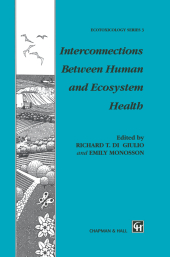 Neuerscheinungen 2014Stand: 2020-02-01 |
Schnellsuche
ISBN/Stichwort/Autor
|
Herderstraße 10
10625 Berlin
Tel.: 030 315 714 16
Fax 030 315 714 14
info@buchspektrum.de |

R. T. Di Giulio, E. Monosson
(Beteiligte)
Interconnections Between Human and Ecosystem Health
Herausgegeben von Di Giulio, R.T.; Monosson, E.
Softcover reprint of the original 1st ed. 1996. 2014. xviii, 275 S. 6 SW-Abb.,. 235 mm
Verlag/Jahr: SPRINGER NETHERLANDS; SPRINGER 2014
ISBN: 9401071810 (9401071810)
Neue ISBN: 978-9401071819 (9789401071819)
Preis und Lieferzeit: Bitte klicken
Ecotoxicology is a relatively new scientific discipline. Indeed, it might be argued that it is only during the last 5-10 years that it has come to merit being regarded as a true science, rather than a collection of procedures for protecting the environment through management and monitoring of pollutant discharges into the environment. The term ´ecotoxicology´ was first coined in the late sixties by Prof. Truhaut, a toxicologist who had the vision to recognize the importance of investigating the fate and effects of chemicals in ecosystems. At that time, ecotoxicology was considered a sub-discipline of medical toxicology. Subsequently, several attempts have been made to portray ecotoxicology in a more realistic light. Notably, both Moriarty (1988) and F. Ramade (1987) emphasized in their books the broad basis of ecotoxicology, encompassing chemical and radiation effects on all components of ecosystems. In doing so, they and others have shifted concern from direct chemical toxicity to humans, to the far more subtle effects that pollutant chemicals exert on natural biota. Such effects potentially threaten the existence of all life on earth. Although I have identified the sixties as the era when ecotoxicology was first conceived as a coherent subject area, it is important to acknowledge that studies that would now be regarded as ecotoxicological are much older.
Introduction. Interconnections between human and ecosystem health: opening lines of comunication. Part 1: Mechanistic Linkages. Ah receptors and the mechanism of dioxin toxicity: insights from homology and phylogeny. Comparative studies of molecular mechanisms of tumorigenesis in herbicide-exposed bivalves. Emerging issues: the effects of endocrine disrupters on reproductive development. Part 2: empirical evidence for linkages. The Great Lakes: a model for golbal concern. Establishing possible links between aquatic ecosystem health and human health: an integrated approach. Part 3: interdependence between human and ecosystem health. Ecosystems as buffers to human health. Interfacing product life cycles and ecological assimilative capacity. Part 4: the risk assessment program. Ecological and human health risk assessment: a comparion. Toxicological and biostatistical foundations for the derivation of a generic interspecies uncertainty factor for application in non-carcinogen risk assessment. Ecological risk assessment and sustainable environmental management. Part 5: socioeconomic and psychological perspectives. Measuring economic values for ecosystems. Perceptions of risk to humans and to nature: a research plan. Perceptions of ecosystem health, stress and human well-being. Part 6: permeation into literature. Ecocriticism: literary studies in an age of environmental crisis. The literature of toxicity from Rachel Carson to Ana Castillo. Synthesis. Ecosystem degradation: links to human health. Index.
...the volume discusses how the same environmental insults affect both humans and the rest of the planet...The main asset of the volume is the strength of the contributors. - Trends in Ecology and Evolution


